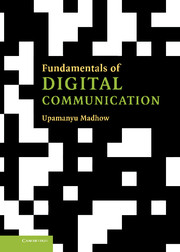Book contents
- Frontmatter
- Contents
- Preface
- Acknowledgements
- 1 Introduction
- 2 Modulation
- 3 Demodulation
- 4 Synchronization and noncoherent communication
- 5 Channel equalization
- 6 Information-theoretic limits and their computation
- 7 Channel coding
- 8 Wireless communication
- Appendix A Probability, random variables, and random processes
- Appendix B The Chernoff bound
- Appendix C Jensen's inequality
- References
- Index
4 - Synchronization and noncoherent communication
Published online by Cambridge University Press: 05 June 2012
- Frontmatter
- Contents
- Preface
- Acknowledgements
- 1 Introduction
- 2 Modulation
- 3 Demodulation
- 4 Synchronization and noncoherent communication
- 5 Channel equalization
- 6 Information-theoretic limits and their computation
- 7 Channel coding
- 8 Wireless communication
- Appendix A Probability, random variables, and random processes
- Appendix B The Chernoff bound
- Appendix C Jensen's inequality
- References
- Index
Summary
In Chapter 3, we established a framework for demodulation over AWGN channels under the assumption that the receiver knows and can reproduce the noiseless received signal for each possible transmitted signal. These provide “templates” against which we can compare the noisy received signal (using correlation), and thereby make inferences about the likelihood of each possible transmitted signal. Before the receiver can arrive at these templates, however, it must estimate unknown parameters such as the amplitude, frequency and phase shifts induced by the channel. We discuss synchronization techniques for obtaining such estimates in this chapter. Alternatively, the receiver might fold in implicit estimation of these parameters, or average over the possible values taken by these parameters, in the design of the demodulator. Noncoherent demodulation, discussed in detail in this chapter, is an example of such an approach to dealing with unknown channel phase. Noncoherent communication is employed when carrier synchronization is not available (e.g., because of considerations of implementation cost or complexity, or because the channel induces a difficult-to-track time-varying phase, as for wireless mobile channels). Noncoherent processing is also an important component of many synchronization algorithms (e.g., for timing synchronization, which often takes place prior to carrier synchronization).
Since there are many variations in individual (and typically proprietary) implementations of synchronization and demodulation algorithms, the focus here is on developing basic principles, and on providing some simple examples of how these principles might be applied.
- Type
- Chapter
- Information
- Fundamentals of Digital Communication , pp. 153 - 198Publisher: Cambridge University PressPrint publication year: 2008
- 1
- Cited by



